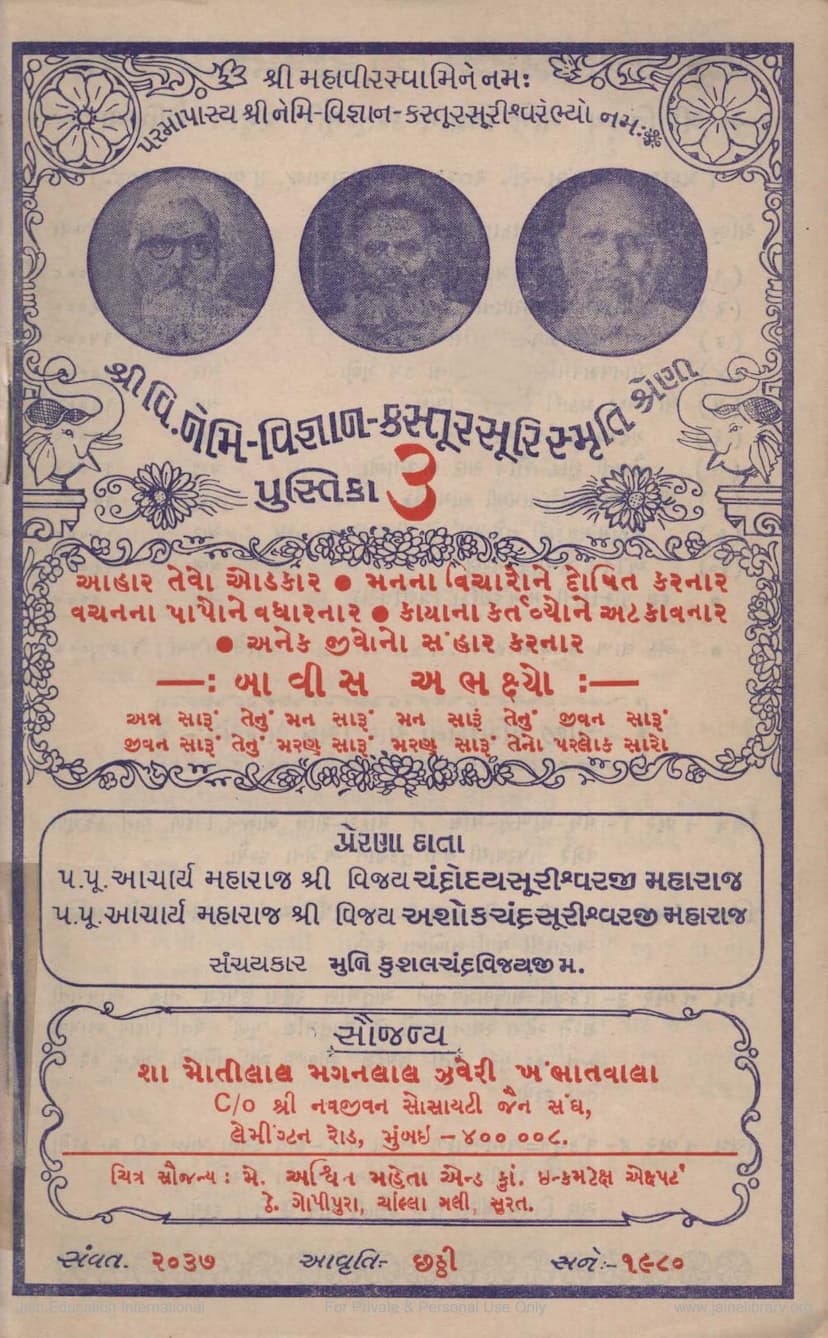Bavis Abhakhsyo Pustika 3
Added to library: September 1, 2025

Summary
Here's a comprehensive summary of the Jain text "Bavis Abhakhsyo Pustika 3" by Kushalchandravijay, focusing on the provided pages:
This book, "Bavis Abhakhsyo Pustika 3" (Twenty-Two Unconsumables Booklet 3), authored by Muni Kushalchandravijayji and published by Nemi Vigyan Kastursuri Shreni, Mumbai, is part of a series aimed at guiding individuals towards a righteous and pure Jain way of life. The publication is dedicated to the memory of Acharya Maharaj Shri Vijay Nem-Vidnyan-Kastursurishwarji Maharaj and Acharya Maharaj Shri Vijay Chandrodayasurishwarji Maharaj and Acharya Maharaj Shri Vijay Ashokchandsurishwarji Maharaj.
The central theme of this booklet revolves around the concept of "Ahara Tevo Odkar" (As the food, so is the burp/thought), emphasizing the profound impact of diet on one's thoughts, actions, and spiritual progress. It asserts that impure food pollutes the mind, amplifies sinful speech, obstructs physical asceticism, and leads to the destruction of countless beings. Conversely, pure food leads to a pure mind, a good life, a good death, and a favorable afterlife.
The booklet details twenty-two categories of "Abhakshya" (unconsumable items) according to Jain principles, explaining the spiritual and physical reasons for their avoidance. It also touches upon thirty-two types of "Anantakaya" (possessing infinite life forms within).
Key Concepts and Narratives:
- The Mahabharata Illustration (Page 3-4): A significant portion of the text uses the incident with Bhishma Pitamah after the Kurukshetra war to illustrate the principle of "Ahara Tevo Odkar." Bhishma, on his deathbed, explains to the Pandavas that his inability to advise them against injustice during the disrobing of Draupadi was due to consuming food obtained through unrighteous means by the Kauravas. This impure food corrupted his thoughts and prevented him from acting justly. Upon his deathbed, with the impure blood leaving his wounds, his thoughts were clear, allowing him to offer wise counsel. This example powerfully demonstrates how the quality of one's food directly influences their thoughts and actions.
- The Five Senses and their Pitfalls (Page 4-5): The booklet elaborates on how attachment to the senses can lead to destruction, citing examples for each:
- Touch (Sparshendriya): An elephant trapped by its desire to touch a fabricated female elephant, falling into a pit.
- Taste (Rasnedriya): A fish caught by the allure of bait, losing its life due to its tongue.
- Smell (Dhranedriya): A snake or bee trapped by fragrance.
- Sight (Chakshuhindriya): Moths attracted to light, leading to their death.
- Hearing (Shravanendriya): Deer captivated by music, leading to their capture. The text argues that these sensory desires, when unchecked, lead to the loss of life and spiritual progress.
- The Concept of Avirati (Non-restraint) and its Karma (Page 5-6): The booklet explains that even if one doesn't actively consume forbidden items, the lingering desire or "avirati" (lack of restraint) associated with them can still incur sin. This is likened to a dormant partnership in a company; even if not actively participating, one is still liable for losses if the formal disassociation isn't completed through a written agreement. Similarly, without a formal vow or "Pachkhaan" (vow of renunciation), the desire for forbidden items leads to the karmic bondage of "avirati."
- Dharma as Medicine (Page 7): The text compares spiritual practices to medicine. Just as a physician prescribes a strict diet (charani/parezi) before administering medicine, Jain dharma advocates for dietary restrictions (Abhakshya, Anantkaya, Vices) as preparatory measures to cleanse the mind and body before engaging in spiritual practices like charity, virtue, penance, and devotion. This cleansing allows the "medicine" of dharma to effectively remove the "diseases" of sin and suffering.
- The Story of Vankachul the Bandit (Page 19-20, 22): A compelling narrative illustrates the transformative power of even simple vows. Vankachul, a wicked bandit prince, upon encountering Acharya Vankachul and his disciples, accepts four simple vows:
- Not to eat unknown fruits.
- To retreat seven steps when faced with a sword strike.
- To consider the king's queen as his sister.
- Not to eat crow's meat. These vows, when tested through challenging situations, not only save his life but also lead him to a path of righteousness and a good end. This story emphasizes that even small, consistently followed vows can have profound positive outcomes.
- Detailed Explanation of Twenty-Two Abhakshya (Page 11-16, 23-27): The booklet systematically lists and explains the reasons for abstaining from:
- Mahavigai (Four Great Forbidden Items): Honey, Meat, Alcohol, Butter. The text details the extensive harm and sin associated with each, including the generation of countless micro-organisms.
- Other Forbidden Items: Ice, Snow, Poison, Soil, Pickles, Night meals, Unknown fruits, Figs from Banyan and Peepal trees, all types of "Tetra" (fruit-like structures), Endless life-form vegetables (Anantakaya), Fermented liquids (Chalitra Ras), Multi-seeded items, Eggplant, and other minor fruits.
- Anantakaya: A comprehensive list of 32 Anantakaya items is provided, emphasizing the principle of non-violence towards the infinite life forms contained within these substances (e.g., roots, tubers, certain vegetables).
- Night Meals (Ratribhojan): This is highlighted as a major sin, akin to a gateway to hell, as it involves harming microscopic organisms active at night and negatively impacts health and vitality.
- Consumption of spoiled or stale food: Also condemned due to the presence of micro-organisms.
- Nutritional Information (Page 28): Towards the end, the booklet includes a comparative chart of the nutritional value of various vegetarian foods, demonstrating that a pure vegetarian diet is not only spiritually beneficial but also nutritionally sound and can provide all necessary nutrients for health.
Overall Message:
"Bavis Abhakhsyo Pustika 3" serves as a practical guide for Jain followers to understand and implement the principles of pure eating. It strongly advocates for a Sattvic (pure) diet as the foundation for a virtuous life, emphasizing that dietary purity is directly linked to mental purity, ethical conduct, and spiritual liberation. The booklet encourages readers to adopt simple vows and practices to avoid sin, attain good health, and progress on the spiritual path.